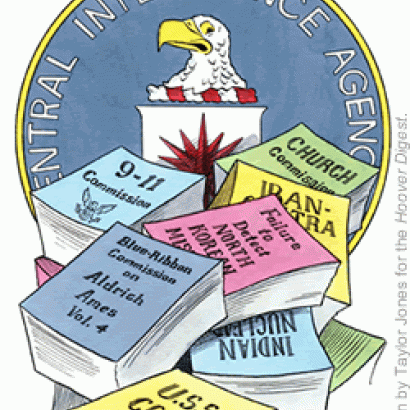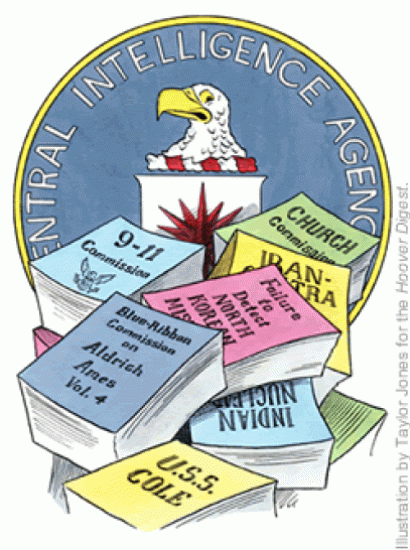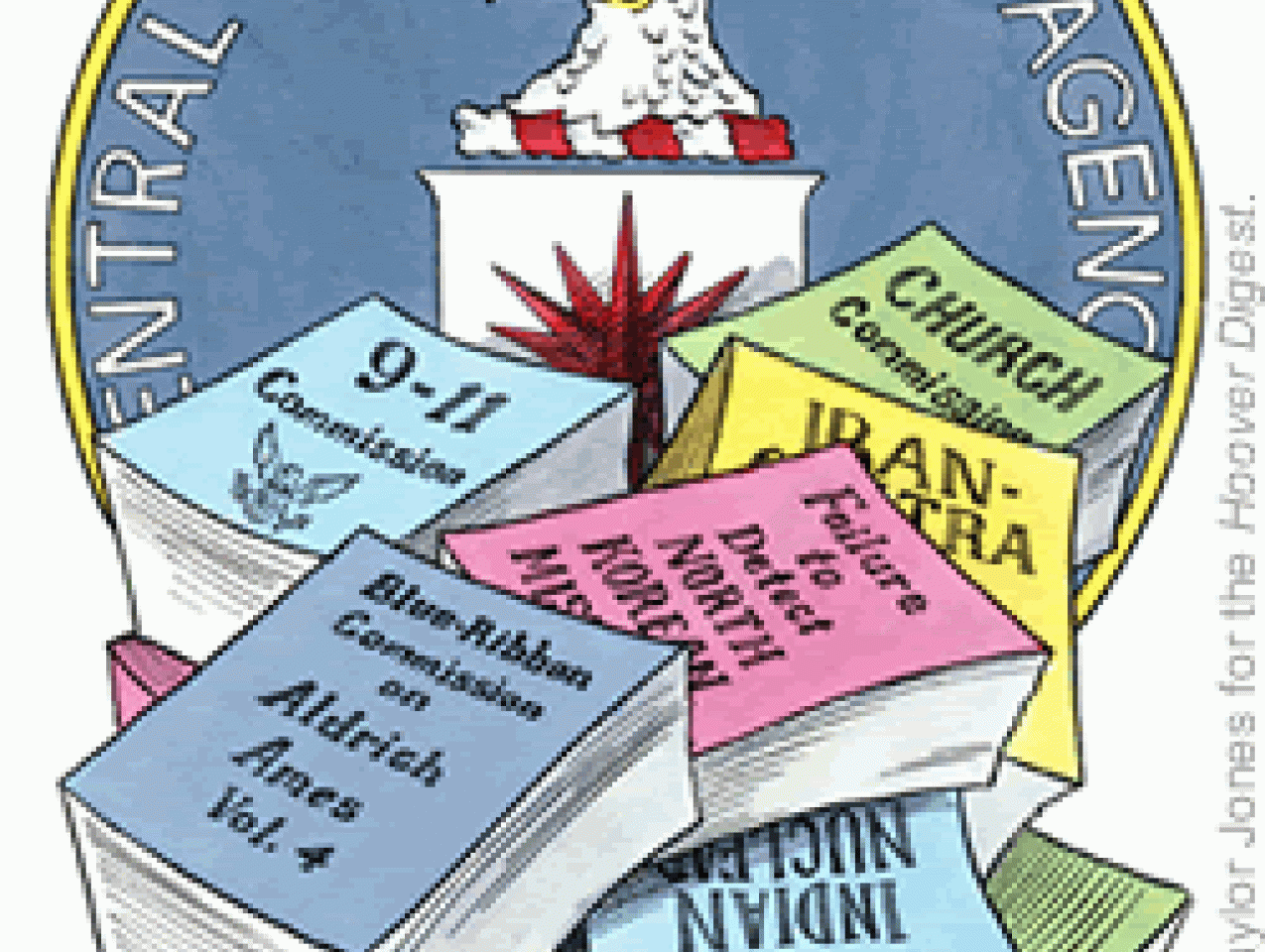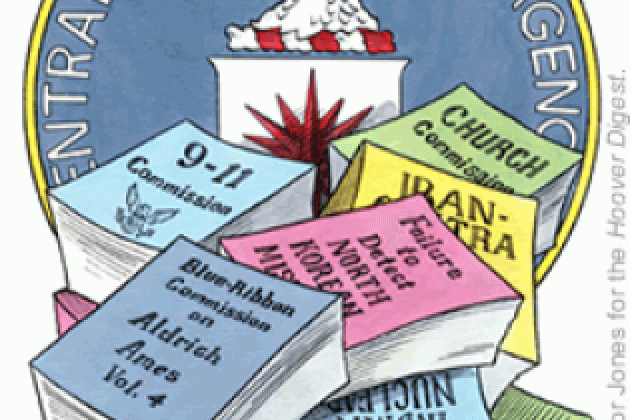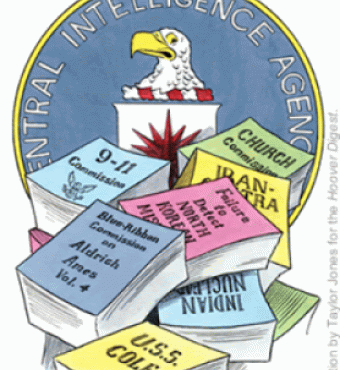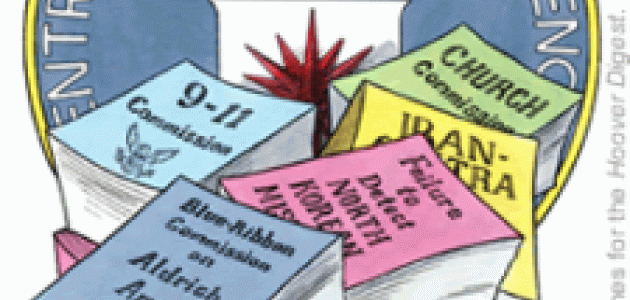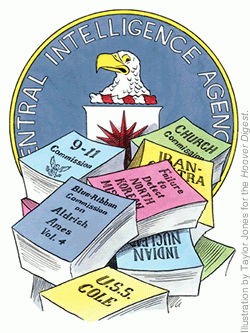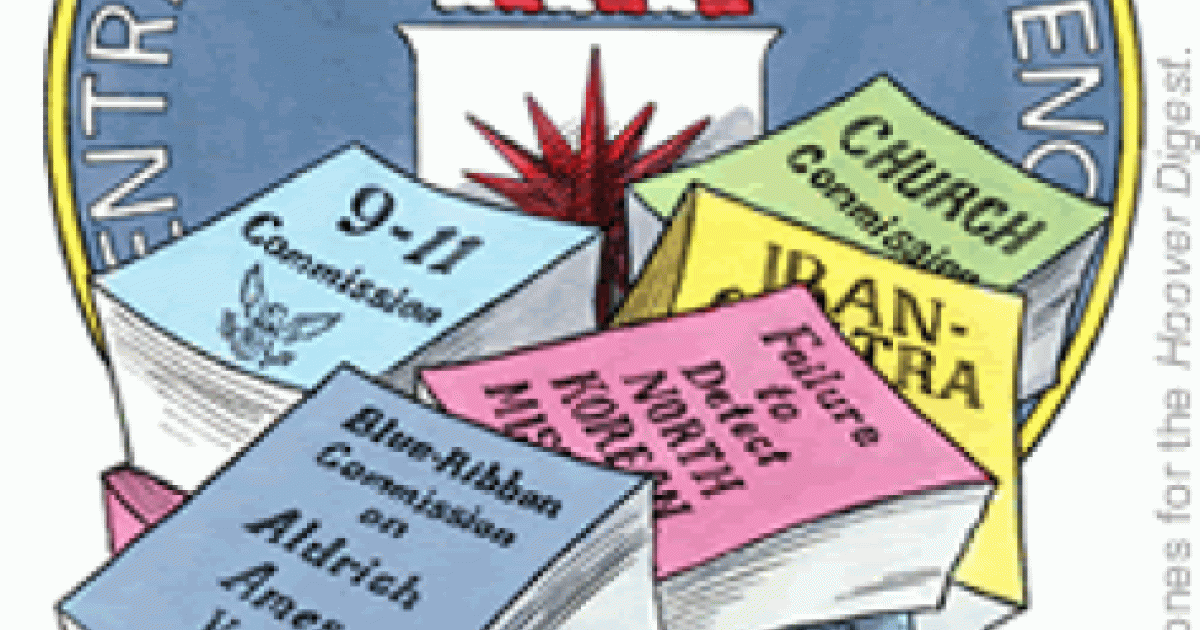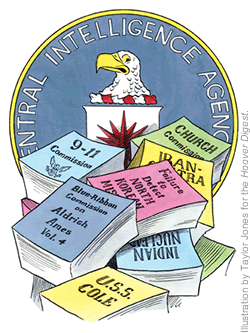
U.S. intelligence agencies, already under fire for not anticipating the September 11 terrorist attacks, are now taking heat from a new crisis—the flap over Iraqi weapons of mass destruction (WMD). Intelligence organizations apparently overestimated Iraq’s progress by a substantial margin. So far, no one has found significant stores of nuclear, biological, or chemical weapons in Iraq, and David Kay, who headed the team responsible for finding them, has said he does not believe further efforts are likely to change this result.
President Bush has appointed a commission to investigate the performance of U.S. intelligence on Iraq’s WMD programs. This is good, because we need to establish an authoritative record of what happened so we are better prepared for the future.
But one has to wonder whether this commission—or any commission—can really fix the problems plaguing U.S. intelligence. During the past decade there have been several such commissions. Indeed, there has rarely been a moment when there was not a commission investigating U.S. intelligence. Consider the following:
• In 1994, Congress authorized the Commission on the Roles and Capabilities of the United States Intelligence Community to consider the future of U.S. intelligence following the Aldrich Ames espionage affair and the end of the Cold War. (This was the “Aspin-Brown Commission,” named for former defense secretaries Les Aspin, who initially chaired it, and Harold Brown, who took over after Aspin died in May 1995.)
• In 1995, the House Permanent Select Committee on Intelligence began its own study of the future of U.S. intelligence, as did organizations like the Council on Foreign Relations and the Twentieth Century Fund.
• In 1996, a commission headed by former director of Central Intelligence Robert Gates investigated alleged bias in a National Intelligence Estimate forecast of the North Korean ballistic missile threat.
• In 1998, a commission headed by retired admiral David Jeremiah investigated the failure of U.S. intelligence to anticipate India’s nuclear test.
• In 2000, several boards and commissions investigated the failure of U.S. intelligence to provide warning of the attack by Al Qaeda on the USS Cole in Yemen (to be sure, this was treated more as a security failure than an intelligence failure).
• Soon after President Bush took office, he approved National Security Policy Directive (NSPD) 5, which authorized a commission to perform a top-to-bottom assessment of U.S. intelligence capabilities and options for improving them.
• Shortly after the September 11, 2001, terrorist attacks, the House and Senate intelligence committees formed a joint inquiry to examine the performance of U.S. intelligence.
• In November 2002, the National Commission on Terrorist Attacks upon the United States—better known as the “9-11 Commission”—started its own investigation of the terrorist strike. Its report, which includes an examination of U.S. intelligence, is scheduled for completion later this year.
With the most recent commission to investigate the Iraqi WMD flap, we have achieved a dubious milestone: We are now appointing new commissions to investigate U.S. intelligence faster than the existing ones can publish their findings. This is even more remarkable when one considers how hard it is for any commission to have a significant effect on the intelligence process.
Commissions take months to convene, staff, and complete their work. Experience shows that commissions require, on average, a year or two to report their results—and even more time to declassify their reports so they can be released for public discussion. During this time, any passion officials might have had for fixing intelligence ebbs and the public’s attention wanders to other matters.
Also, commissions have little clout. They are not connected to any of the real levers of power. They can’t legislate, and they don’t control the organizations they review. Because Congress is geared to the annual legislative calendar, it takes at least a year—or more—for it to act on a commission’s recommendations and another year for the executive branch to implement the legislation. And, while all of this is going on, everyone is apt to put off major changes, saying that they should wait until any currently active commissions finish their work.
Little wonder commissions often have the opposite of their intended effect—they stall reforms rather than facilitate them. To be fair, reforming U.S. intelligence is an inherently tough assignment. Like any bureaucracy, intelligence organizations are insulated from market forces, which compel businesses to adapt constantly to changing conditions, or elections, which reshape political bodies at regular intervals. But, unlike other bureaucracies, the intelligence community has features that make it especially resistant to change.
Most intelligence activities are classified, so data that experts in other fields take for granted—budgets, staffing, and performance—are unavailable and cannot be presented to the public to make a case for change. Imagine trying to analyze education policy without being able to discuss how many teachers are on the payrolls, how much the country spends on schooling, or how student test scores have varied over the past two decades, and you get an idea of the problem.
Reform: The Traditional Approach
Commissions have offered many, many recommendations for reforming U.S. intelligence, but most fit into three basic categories:
The first is creating czars. For example, the House-Senate joint inquiry into the September 11 intelligence failure recommended creating a new Director of National Intelligence (DNI) who would be responsible for all intelligence resources other than those used by combat forces at the tactical level. The NSPD 5 study reportedly made a similar recommendation. The Aspin-Brown Commission proposed creating a new Deputy Director of Central Intelligence for Community Management in 1996, only to see the Senate Select Committee on Intelligence up the ante and propose creating three Assistant Directors of Central Intelligence (one for planning collection, one for planning analysis, and one for administration). As might be expected, the compromise was to adopt both proposals, so that by 1998 U.S. intelligence had four new executive positions.
The second is rearranging or restructuring organizations. Such reorganization was used in 1992, for example, when Air Force, CIA, and Navy satellite programs were integrated within the National Reconnaissance Office (NRO). It was also used when, in 1996, CIA and Defense Department imagery analysts were consolidated into the National Imagery and Mapping Agency (NIMA). More recently, according to press reports, the NSPD 5 study recommended moving the National Security Agency (NSA), NRO, and NIMA out of the Defense Department and putting them under the direct control of the proposed DNI.
The third is giving officials or organizations new authorities. Logically enough, these proposals usually accompany the preceding two. For example, some experts who want to create a Director of National Intelligence propose giving that person authority to move people and money freely among intelligence agencies so that she or he can concentrate resources on the most important targets. Similarly, proposals for consolidating intelligence agencies are usually aimed at pulling authority for planning and coordination inside a single organization.
Creating czars, rearranging organizations, and assigning new authorities are all tempting, partly because they bring to mind the Goldwater-Nichols Act of 1986, which reformed the Defense Department. Most experts agree that Goldwater-Nichols improved U.S. military capabilities. They compare, for example, the failed Iranian hostage rescue operation in 1980 (when Army, Navy, and Air Force components did not cooperate effectively) with Operation Desert Storm in 1991 (when they did).
Alas, all these proposals may seem reasonable, but none of them address the most important problem facing U.S. intelligence. The problem is not that U.S. intelligence is poorly organized; the problem is that it lacks the specific capabilities it needs to deal with new threats such as terrorism, rogue states, and proliferation of weapons of mass destruction. No amount of reorganization can compensate for that gap.
Also, reorganization is not the key to making intelligence organizations work together. The barriers that keep organizations from sharing information effectively and teaming up to crack hard targets could be solved with less drastic measures. For example, today organizations often impose their own rules for protecting information—despite repeated instructions to standardize them. As a result, organizational boundaries become information barriers. But this is a function of policy and the priority officials place on their agencies cooperating with each other, not how boxes are arranged on an organization chart.
That was the real reason the Goldwater-Nichols reforms were so effective. It wasn’t just a matter of reorganization. Rather, Goldwater-Nichols forced the Army, Navy, and Air Force to concentrate on improving “jointness”—military jargon for the ability of services to work together. In practical terms, jointness meant the services had to design their communications and weapons systems to a common standard so they could communicate with one another, and officers were required to do a stint in an assignment outside their own service to broaden their perspectives.
Proposals to yank intelligence organizations out of the Defense Department also overlook the role they play in combat operations today. The ability to feed electronic data to units on the battlefield through digital pipelines is essential for the kind of network-style warfare that has proved so effective in Iraq and Afghanistan. Combat forces use more of this data than anyone else. It seems odd that anyone would want to drag several intelligence organizations out of the Defense Department simply to create a new mega-organization whose main mission would be . . . supporting the Defense Department.
True, we need digital intelligence for more than just military operations. But there are many ways to ensure other agencies can get these data—reserving a certain amount of priority use for non-defense agencies, giving them funds to collect the data themselves—or buying it from outside. Today, about the only digital information that government agencies have a unique advantage in collecting is communications intercepts.
Most of the rest—satellite imagery, for example—can be collected, processed, and analyzed in-house or bought commercially. Generally speaking, such competition among many sources improves the product.
Reform: An Alternate Approach
Intelligence reform ought to concentrate on creating new capabilities and removing obstacles that keep us from using our existing capabilities effectively.
Consider some of the specific problems U.S. intelligence currently faces:
• Because the CIA—the agency with the lead responsibility for espionage—relies so heavily on “official cover” (that is, disguising intelligence officers as run-of-the-mill U.S. officials), it has difficulty operating in countries where the United States has no representation. The use of official cover also limits opportunities to penetrate some of our most important targets, such as terrorist organizations or rogue states. (See “Deep Cover,” Hoover Digest, fall 2002.)
• Security procedures, as noted previously, often prevent intelligence organizations from sharing data and working together effectively. Largely because of security, analysts are too insulated from both consumers and the targets they cover. Current security procedures make it hard for analysts, case officers, and technical specialists to cooperate in identifying and penetrating targets. It is often challenging for anyone inside the intelligence community to use outside information and expertise.
• The intelligence community as a whole does not have enough opportunities for the kind of entrepreneurship needed to develop out-of-the-box approaches to analysis, espionage, and technical collection. Because it is a mature organization, the intelligence community does not attract enough risk-takers. Those that do join are often frustrated by layers of bureaucracy and cumbersome procedures. As a result, U.S. intelligence is too slow to act on new ideas or adopt new technologies and, with a few exceptions, it is hard for anyone to act outside established ways of doing business.
• Intelligence officials lack basic administrative tools that the private sector takes for granted—for example, software and accounting systems that tell managers how their analysts and collection assets are allocated at a given moment. As a result, they cannot reallocate people and resources effectively as requirements and conditions change—and the intelligence community as a whole lacks agility. (See “Spying in the Post–September 11 World,” Hoover Digest, fall 2003.)
The gathering consensus on the need for intelligence reform gives us a chance to address these problems—much as the consensus on the need for military reform transformed the Defense Department in the 1980s. But we need to be smart in how we do it. Remember that, in the real world, complex plans to reorganize big government organizations rarely turn out as planned and often have unintended consequences.
That’s why I recommend focusing on two simple objectives: (1) removing barriers that keep all intelligence organizations from working together effectively and (2) beefing up the CIA so that it is better prepared for meeting the intelligence needs of nonmilitary users.
If we spent less effort debating organizational schemes, we might be able to focus the political will needed to make all intelligence organizations implement a truly common set of security standards that balance the importance of keeping secrets with the importance of sharing information. Then we could focus on strengthening the CIA, which has a unique role that no other agency can fill. Some of the steps that are urgently required include
• Creating a new, truly clandestine human intelligence service in the CIA to supplement the current Directorate of Operations. Its main mission would be penetrating foreign targets unilaterally, secretly, and without the assistance of other countries’ intelligence services. It would be based outside CIA headquarters to ensure that it has effective cover. It would form relationships with American businesses and other organizations to establish presence in areas where the United States has no official representation. All members of this organization would be undercover throughout their careers and would be protected by the Intelligence Identities Act—meaning that disclosure of their connection to U.S. intelligence would be a crime.
• Refocusing the Directorate of Operations on the kinds of activities that it is most suited for: covert activities that do not require deep cover and which fully exploit the advantages of official cover. These include, for example, working with foreign intelligence agencies, recruiting “walk-ins” (foreigners from hostile regimes and organizations who volunteer their services to U.S. intelligence), organizing paramilitary operations like the ones that proved effective in Afghanistan, and providing covert security assistance to allies.
• Refocusing the Directorate of Science and Technology on the kinds of activities it has historically done well—specifically, serving as a “skunk works” to field new technology fast in the classic style of, say, the U-2 reconnaissance aircraft or CORONA, the first imaging satellite.
• Making the Directorate of Intelligence the main window between the classified and unclassified worlds. Its analysts—who are not undercover and should not be encouraged to think they are undercover—should be given more opportunities, incentives, and funding to mix easily with people in academia, business, and the media and tap all publicly available sources of information and expertise.
In short, we would be much better off letting established organizations focus on their “core competencies”; make it easier for everyone to share information and work together; and create opportunities for new organizations to address new missions and attract risk-takers.
Most of these measures would not require major legislation. They could be accomplished by drafting a replacement for Executive Order 12333—the presidential directive that currently serves as the intelligence community’s charter. EO 12333, which defines the roles, responsibilities, and prerogatives of intelligence organizations and the officials who run them, was signed by Ronald Reagan in 1982—more than 20 years ago. It was drafted when the Soviet Union was still an ominous threat, the Information Revolution was barely under way, and Osama bin Laden was just the obscure seventh son of a Yemeni construction tycoon.
A new executive order is needed that would be a faster, more effective vehicle for intelligence reform than a commission report or legislation. Such an order could also resolve the security barriers and other hurdles that currently keep intelligence agencies from working together more effectively. And, since it would have the authority of the president, it would have the required clout over department heads and other top officials down the line—especially if the president named a White House–level representative whose chief task would be to ensure it was implemented.
This isn’t the time for grand designs. We need to focus on practical measures to develop real capabilities for dealing with the threats that face the country today.








